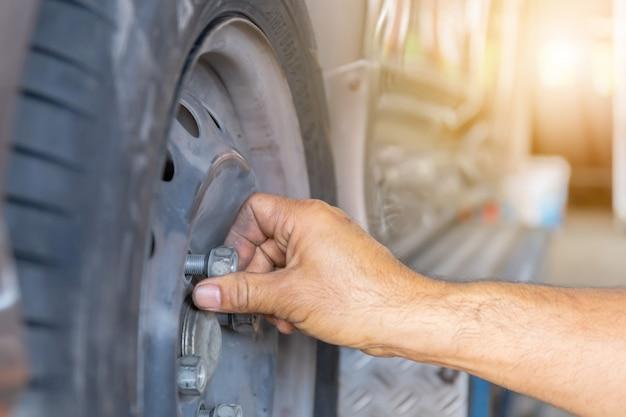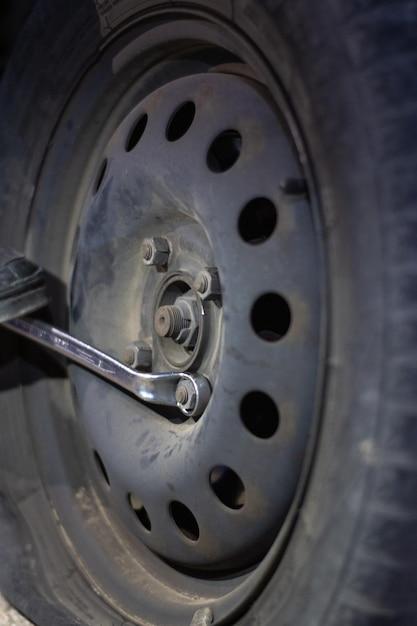When it comes to loosening nuts and bolts, knowing which direction to turn can be a puzzle for many. We’ve all heard the sayings “Lefty Loosey, Righty Tighty” or “Righty Tighty, Lefty Loosey,” but what do they really mean? In this blog post, we’ll dive into the mechanics behind these phrases and uncover the truth about loosening nuts.
We’ll also discuss common tools and techniques used to loosen stubborn nuts, including the use of WD-40, propane torches, and sprays. Additionally, we’ll explore the difference between clockwise and anticlockwise and provide some easy-to-follow tips for releasing tight nuts without the need for a socket wrench.
So whether you’re a DIY enthusiast, a novice at handy work, or simply curious about the science of loosening nuts, this blog post will equip you with the knowledge and confidence to tackle any tight bolts that come your way in 2023 and beyond. Let’s get started!
Which Direction To Loosen A Nut
When it comes to loosening nuts, it’s important to know which way to turn. Trust me, you don’t want to end up going in the wrong direction and tighten it even more. It’s a frustrating situation that we’ve all found ourselves in at one point or another. But fear not! In this guide, we’ll tackle the age-old question: Which direction should you loosen a nut?
Righty Tighty, Lefty Loosey
You’ve probably heard the saying “righty tighty, lefty loosey” before, but what does it actually mean? Well, it’s a simple rule of thumb that can help you remember which way to turn a nut. When you turn a nut to the right, or clockwise, you’re tightening it. And when you turn it to the left, or counterclockwise, you’re loosening it. Easy, right?
But Wait, There’s More
While “righty tighty, lefty loosey” is a handy rule, there are a few exceptions that can throw you off. One such exception is with certain specialized nuts, like those found on bicycle pedals or some plumbing fixtures. These nuts have reverse threads, which means they turn the opposite way compared to regular nuts. So, in these cases, you’ll need to turn them to the left to tighten and to the right to loosen. Who knew nuts could be so complicated?
The Trick with Rusty Nuts
Ah, rusty nuts. They’re the bane of every DIYer’s existence. When confronted with a rusty nut, the rules can change a bit. Rust can make a nut stubborn and resistant to movement, which means you might need to put in some extra effort to loosen it. One trick is to spray some penetrating oil, like WD-40, and let it sit for a few minutes. This can help lubricate the threads and make it easier to loosen the nut. And remember, always turn the nut in the appropriate direction based on the regular rules—clockwise to tighten and counterclockwise to loosen.
When All Else Fails, Ask for Help
Sometimes, no matter how many tricks you try, a nut just won’t budge. It happens to the best of us. When you’re facing a seemingly immovable nut, don’t be afraid to ask for help. Whether it’s a friend, a family member, or a professional, having an extra set of hands (or some specialized tools) can make all the difference. Plus, it’s always more fun to tackle DIY projects with someone else by your side.
Loosening nuts may seem like a simple task, but it’s essential to know the proper direction to avoid getting stuck in a frustrating situation. Remember the trusty rule of “righty tighty, lefty loosey,” unless you’re dealing with reverse-threaded nuts. And if you encounter a rusty nut, a little penetrating oil and patience can go a long way. Don’t be afraid to ask for help when needed, and soon enough, you’ll be a pro at loosening nuts in no time. Happy DIYing!
Keywords: Direction to loosen a nut, righty tighty, lefty loosey, reverse threads, rusty nuts, penetrating oil, DIY projects, asking for help.
FAQ: Which Direction to Loosen a Nut
Welcome to our FAQ section on how to loosen nuts and bolts. If you’ve ever found yourself struggling with a stubborn nut, you’re not alone. In this comprehensive guide, we’ll answer your most pressing questions about which direction to turn a nut to loosen it. So grab your wrench and let’s get started!
1. What does “Lefty Lucy” mean
“Lefty Lucy” is a popular phrase used to remember which direction to turn a nut or bolt to loosen it. In this context, “Lefty” refers to turning the nut counterclockwise or to the left.
2. Why is it “Lefty Loosey, Righty Tighty”
The phrase “Lefty Loosey, Righty Tighty” is a simple mnemonic device to help you remember the way to turn a nut. By associating “Lefty” with loosening and “Righty” with tightening, it becomes easier to decipher the correct direction.
3. How long does WD-40 take to work
While there isn’t a set time frame for WD-40 to work, it usually starts to loosen rusted or stuck nuts within a few minutes. For best results, apply WD-40 to the nut and let it sit for about 5 to 10 minutes before attempting to loosen it.
4. Will a propane torch loosen bolts
Yes, a propane torch can be used to help loosen stubborn bolts. By applying heat to the bolt, it expands and breaks the bond between the threads, making it easier to turn and loosen.
5. Is plumbing “Righty Tighty, Lefty Loosey”
In most cases, plumbing follows the “Righty Tighty, Lefty Loosey” rule. However, it’s important to note that not all plumbing components may follow this convention. Always refer to specific instructions or consult a professional plumber when in doubt.
6. What to spray on bolts to loosen
To help loosen bolts, you can use penetrating oils like WD-40, PB Blaster, or Liquid Wrench. These oils are designed to seep into the threads and break the rust or corrosion that may be causing the bolt to stick.
7. Is counterclockwise loosen
Yes, counterclockwise turning is the standard direction for loosening nuts and bolts. When facing the nut, turn it to the left or counterclockwise to loosen it.
8. How do you loosen bolts clockwise or counterclockwise
To loosen bolts, turn them counterclockwise or to the left. Conversely, to tighten bolts, turn them clockwise or to the right. Remember the phrase “Lefty Loosey, Righty Tighty” to help you remember the correct direction.
9. What is the easiest way to open a nut and bolt
The easiest way to open a nut and bolt is by using the appropriate tools, such as a wrench or socket set. Apply steady pressure while turning counterclockwise to loosen the nut. If the nut is particularly stubborn, using a lubricant like WD-40 can make the process smoother.
10. Is it “Lefty Loosey, Righty Tighty” or “Righty Tighty, Lefty Loosey”
The correct phrase is “Lefty Loosey, Righty Tighty.” Remember, turning counterclockwise or to the left (Lefty) will loosen the nut, and turning clockwise or to the right (Righty) will tighten it.
11. What is the difference between clockwise and counterclockwise
Clockwise refers to the direction in which the hands of a clock rotate, which is from left to right. Counterclockwise, on the other hand, is the opposite direction, going from right to left. Understanding these terms is essential for knowing which way to turn a nut or bolt.
12. How do you loosen a socket
To loosen a socket, place the appropriate size socket onto the nut or bolt. Attach a ratchet handle to the socket and turn it counterclockwise or to the left. Apply steady pressure while turning until the nut loosens.
13. Is an oil filter “Lefty Loosey”
Yes, in most cases, oil filters follow the “Lefty Loosey” rule. When it’s time to change your oil filter, turn it counterclockwise or to the left to loosen it. Always check your vehicle’s manual for specific instructions.
14. Where is anti-clockwise
“Anti-clockwise” refers to the counterclockwise direction. It is the opposite of clockwise and involves turning from right to left when facing a nut or bolt.
15. Who is righty
Righty isn’t a person! In the context of “Lefty Loosey, Righty Tighty,” “Righty” refers to turning a nut or bolt in a clockwise or right direction to tighten it.
16. Is east to west clockwise
No, east to west is not always considered clockwise. Clockwise and counterclockwise refer to circular motion, whereas east to west denotes horizontal directional movement.
17. Which way in counterclockwise runs, left or right
Counterclockwise motion runs from right to left. This means that when turning a nut or bolt counterclockwise, you are turning it in the left direction.
18. Why is clockwise to the right
The convention of associating clockwise with the right direction stems from the traditional design of clocks and watches. The hands of these timepieces move in a clockwise direction, from left to right, as time progresses.
19. What can I use if I don’t have a socket wrench
If you don’t have a socket wrench, you can use an adjustable wrench or a pair of pliers. These tools allow you to grip and turn nuts or bolts by adjusting their width or position. However, be cautious as these alternatives may not provide the same level of control as a socket wrench.
20. Do you turn left or right to unscrew
To unscrew a nut or bolt, turn it in the counterclockwise direction or to the left. This motion will gradually loosen and ultimately remove the fastener.
21. Do babies turn clockwise or counterclockwise
Babies don’t adhere to a specific turning direction! However, when referencing “clockwise” or “counterclockwise” in relation to babies, it typically pertains to the rotation of their head during labor or childbirth.
22. How do you release a tight nut
To release a tight nut, apply penetrating oil, such as WD-40, to lubricate the threads. Let the oil work its way in for a few minutes. Then, use an appropriate tool, such as a wrench or socket, and turn counterclockwise with steady pressure until the nut loosens.
23. Which direction would you turn a spanner to loosen a nut
To loosen a nut with a spanner (also known as a wrench), turn it counterclockwise or to the left. Fit the spanner onto the nut and apply rotational force in the opposite direction of clock hands, remembering “Lefty Loosey.” Gradually, the nut will loosen.
We hope this FAQ section has shed some light on the often puzzling question of which direction to turn a nut to loosen it. Remember, when dealing with nuts and bolts, “Lefty Loosey, Righty Tighty” is your trusty guide. Happy tinkering, and may your nuts always loosen with ease!

